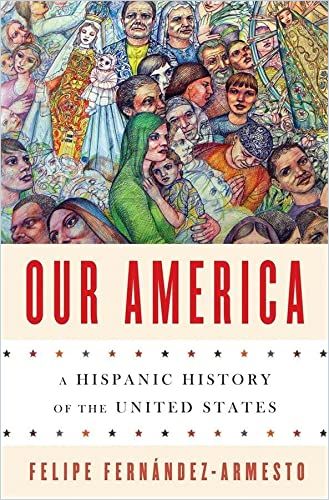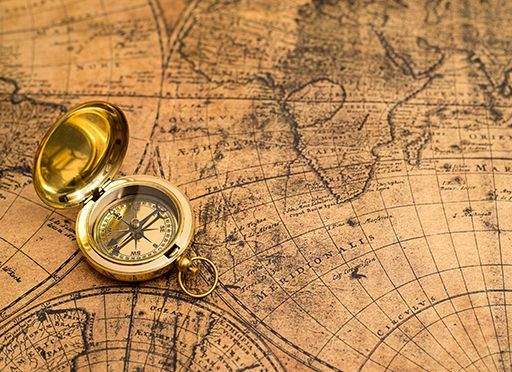Professor Felipe Fernández-Armesto presents a Hispanicist’s history of North America, starting with the arrival of Christopher Columbus.

Hispanic Roots
Felipe Fernández-Armesto, a history professor at the University of Notre Dame, ardently chronicles US Hispanic history, presenting evidence to give it the dominance he feels it deserves.
Hispanics preceded the United States in what is now national territory. Their presence has been a longer part of the history of the land than that of any other intruders from across the Atlantic, including Anglo-Americans.Felipe Fernández-Armesto
He maintains that for the United States to embrace its multicultural future, Anglo-Americans must recognize Hispanics’ historic roots and crucial contributions to the United States.
Colonizers
The Spanish history in North America began much earlier than the arrivals of explorers from other European countries.
In 1493, on Christopher Columbus’s second voyage to the New World under the Spanish flag, he landed at an island (Puerto Rico) that he called San Juan Bautista to honor the Spanish Crown. Fernández-Armesto reports that the Indigenous people viewed the invaders with awe and ceded control to them willingly.
They bring with them the aura of the divine horizon.Mary W. Helms, anthropologist
Not every historian agrees with that characterization, and the Indigenous people eventually rebelled and were nearly wiped out. While the author presents the adventures of the “conquistadores” with pride, he gives somewhat short shrift to their plundering or genocides. He does report that the Spanish carried smallpox, which killed much of the Indigenous population.
In the 1520s, settlers brought enslaved workers from Africa to the Caribbean. Relying on unpaid labor, Hispanics transformed Puerto Rico (after its initial gold boom) into a land of sugar plantations. By the early 1700s, Puerto Rico brought prosperity to the Spanish Empire – on the backs of the enslaved.
Spanish explorers, including Ponce de Leon, also went to Florida.In 1565, Pedro Menéndez de Avilés established strongholds there, expanding from Florida’s St. John’s River north to Chesapeake Bay. But these encampments were short-lived; by 1574, only two of his settlements remained.
The Southwest
In 1539, Esteban de Dorantes or “Estebanico,” a Black enslaved person and a celebrated explorer, ventured north of Sonora, Mexico. Mortally wounded and hallucinating on his deathbed, Estebanico claimed to have seen the emerald city of Cíbola. Inspired, more Spaniards set forth to North America.
Francisco Vázquez de Coronado, who ventured from Mexico to Kansas between 1540 and 1542, was one conduit in introducing horses to Native Americans, transforming their ability to hunt and make war.
Juan de Oñate reached the Rio Grande in today’s New Mexico in 1598. He found empty pueblos and sparse populations, because smallpox spread by previous Spanish explorers had decimated the Indigenous people. Oñate moved to Santa Fe, New Mexico in 1610.
Spaniards, never did more than nibble around the margins of the plains. Felipe Fernández-Armesto
Horses enabled Apache and Comanche raids on French and Spanish outposts in Texas, halting Spanish expansion northward and pushing the Spanish into Arizona and California.
Territory Changes Hands
After the end of the Seven Years War in 1763, Britain seized Canada from the French and Florida from Spain. Spain sided with the American patriots in the Revolutionary War against Britain, thereby regaining Florida and displacing France in Louisiana.
Declining Empire
As the United States sought to procure the Mississippi River, Anglo-American immigrants flooded the territory. To create a buffer between its western colonies and an expanding America, Spain gave Louisiana to Napoleon, who promptly sold it to the United States in 1804.
Intruders will establish their own customs, laws and religion.Manuel Gayoso de Lemos
Mexico claimed independence, and people from Mexico moved north into California between 1831 and 1845. In Texas, they clashed with Anglo immigrants who set up cotton-growing operations dependent on enslaved laborers. In 1846, Mexico lost control over the Southwest and California, marking the end of Spanish territory in the United States.
The 1849 California gold rush lured both Anglo-Americans and Mexicans, leading to increased racial tension. Open Mexican immigration lasted only until laborers completed the railway across the continent in the 1870s. As would happen in the 1920s, America’s openness to these immigrants grew and shrank depending on its need for laborers.
Last Territories
The United States sought to seize Mexican territory after 1852. Southern owners of enslaved people felt emancipation looming and regarded Mexico as a potential haven for preserving enslavement. Mexico ceded land, but mostly resisted incursion.
The arrest or self-limitation of expansion guaranteed the triumph of Anglo-America.Felipe Fernández-Armesto
The United States expanded into the Pacific, taking Hawaii and Guam in 1898 and Samoa in 1899. Between 1899 and 1902, it gained Puerto Rico and Guantanamo, the last colonies of the Spanish Empire.
Mexicans and the Southwest
The industrialization of the West brought Mexicans pouring back into their former US territories in the 1890s. They faced harsh, often racist, reactions from Anglo-American populations. For example, the governor of Colorado, a member of the Ku Klux Klan, tried to ban all Catholic immigrants in 1924.
Politicians created laws systematically excluding Hispanics from equal opportunity by denying them US citizenship or fair labor rights.
Still, some 283,000 Mexicans came to the United States between 1925 and 1929. But, when the Depression dried up the labor market, the United States deported Mexican workers, including more than half a million from Los Angeles County alone.
US policy, rather than the wishes of immigrants, decreed migrants’ movements.Felipe Fernandez-Armesto
When the US government needed low-cost labor, it opened its borders, and when the economy failed, it blocked immigration. But since American jobs paid higher wages than those in Mexico, many people found the hazardous border crossing worthwhile.
Assimilation
After the First World War, US Hispanic populations increased dramatically; racist stereotyping and systemic discrimination rose proportionally. People from Central and South America built communities around the demand for workers, filling jobs in such undertakings as the rebuilding New Orleans after Hurricane Katrina.
Myths are motors of history. Facts that happen are often powerless to affect behavior. People act on the basis of the falsehoods they believe. Felipe Fernández-Armesto
Today, members of the US Hispanic population must decide whether to assimilate or to band together to preserve their cultural heritage. Since the Hispanic population in the United States now exceeds 50 million people, the nation must view Hispanic immigrants as people returning to their ancestral homes and must recognize and incorporate its own Spanish roots.
Impassioned History
Felipe Fernández-Armesto filters his history through a thoroughly Hispanic-centered view, even if it means showing less interest in other populations. Given the centuries of Anglo-American chronicles that seldom mentioned the contributions of Hispanics, his backlash history seems historically inevitable.
There was never a time when most Americans, or most people in what is now the United States, were white English Protestants. Felipe Fernández-Armesto
Fernández-Armesto is, accordingly, assertively focused – at times, even one-sided – on preaching to his choir, and he shows little sympathy for the people whom Spanish explorers exploited, enslaved and infected with disease. He makes valid points about Spain’s exploration and establishment of colonies in North America dating back to the 1490s. Although other colonizers committed similar sins, the author seems surprisingly proud of the Spanish empire. This is another anomaly in a work with many, but also, perhaps, a counterbalance to the prevailing narrative. His lively prose, his manifesto of Hispanic pride and his fulsome information about America’s Hispanic heritage will engage Hispanics and educate everyone else.
Felipe Fernández-Armesto has written more than nine books published in 27 languages. They include Pathfinders: A Global History of Exploration; Straits: Beyond the Myth of Magellan; and 1492: The Year the World Began.









